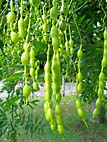The pea-family or Leguminosa or Fabaceae-familie
Finding out what Leguminosa species you are dealing with.
The leguminosa is the family including beans: the Latin means "vegetables".
This clearly shows wit regard to the fruit on the trees of this family: mainly brown bean-pods. Non of these trees are originally form the Netherlands. But the Black locust (called Acacia in Dutch) was imported in the 19th century and is now commonly seen in Dutch forests (not as common as native species though). The Black locust, Honeylocust, Kentucky coffeetree and Mimosa all have flat brown pea-pods as fruit. They also share leafs that look like fern-leafs: feather leafs where two leafs are always opposite to each other.
Finding out what tree you are dealing with since many cultivars are located in gardens and parks and along roads. Here is the overal picture though:
- Black locust - Robinia pseudoacacia has compound leaves. Characteristic are the until 10 cm long paired thorns at the base of twigs (sometimes missing because of cultivation). The bark is exceptionally rough and beautiful. The branches are often capricious, but not always. The flowers are big and white and grow in bunches like grapes. In the fall the fruit appears as 5-10 cm long flat brown pods. These open up and fall off until march and later (until early spring.) The tree becomes 30-35 meters tall and filters light in a nice way: it is not very dark under the tree. The wood is very hard. See here for a list of cultivars.
- The Honeylocust (Dutch word is Christ-thorn) or Gleditsia triacanthos looks like the black locust, but has a trunk without any rough bark. It has finer leafs and can have bunches of long needled thorns also on the trunk, like cacti have. Cultivars may lack those. The pea-pods are much longer (upto 40 cm) and thicker than the Black locusts' and have a curl in them. Many trees do not have pods at all, but if they do often in abundance. These pods are also on the tree until late winter. See here. . The trunk is fairly smooth and grey/green but when the tree gets bigger some patches of greyish bark can be formed.
- I have no photos of the Kentucky coffeetree or Gymnocladus dioicus nor of the Mimosa or Acacia dealbata, since they are mostly foreign to the Netherlands.
Here is some more info on Gymnocladus dioicus. I am wondering if they grow in the Netherlands.
- The Japanese scholartree or Saphora japonica is a tree calles "pagodetree" in Ditch. The pods look like a pagode, because they are in layers. Have a look at the pics and you will understand. It is not a Dutch tree at all, but grows in my neighbourhood.
The
Golden chain tree is also a member of the Pea family, which size is between a tree and a shrub. It can be found in gardens and parks only.
All species photographed.
Leafs.

Black locust Japanese scholartree or Saphora japonica
Winter photo's of bark and buds, if available.






Honeylocust




















